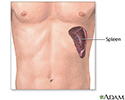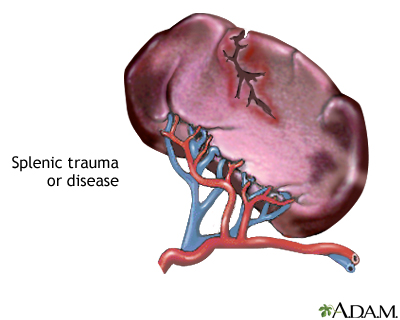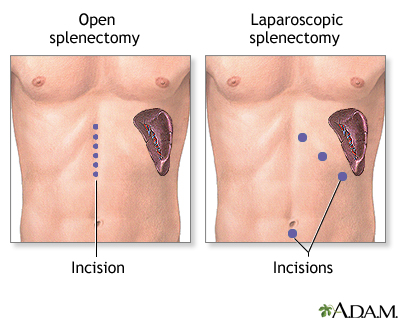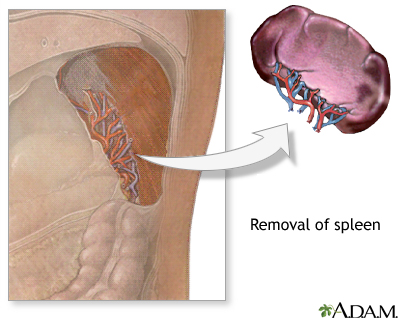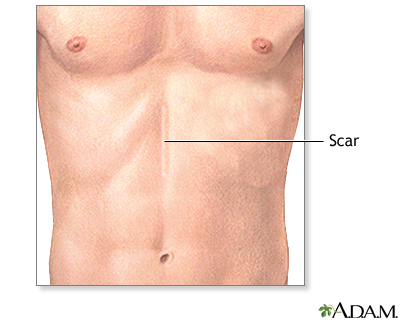Spleen removal
Splenectomy; Laparoscopic splenectomy; Spleen removal - laparoscopic
Spleen removal is surgery to remove a diseased or damaged spleen. This surgery is called splenectomy.
The spleen is in the upper part of the belly, on the left side underneath the ribcage. The spleen helps the body fight germs and infections. It also helps filter the blood.
Description
The spleen is removed while you are under general anesthesia (asleep and pain-free). The surgeon may do either an open splenectomy or a laparoscopic splenectomy.
General anesthesia
General anesthesia is treatment with certain medicines that puts you into a deep sleep so you do not feel pain during surgery. After you receive the...
During open spleen removal:
- The surgeon makes a cut (incision) in the middle of the belly or on the left side of the belly just below the ribs.
- The spleen is located and removed.
- If you are also being treated for cancer, lymph nodes in the belly are examined. They may also be removed.
- The incision is closed using stitches or staples.
During laparoscopic spleen removal:
- The surgeon makes three or four small cuts in the belly.
- The surgeon inserts an instrument called a laparoscope through one of the cuts. The scope has a tiny camera and light on the end, which allows the surgeon to see inside the belly. Other instruments are inserted through the other cuts.
- Gas is pumped into the belly to expand it. This gives the surgeon room to work.
- The surgeon uses the scope and other instruments to remove the spleen.
- The scope and other instruments are removed. The incisions are closed using stitches or staples.
With laparoscopic surgery, recovery is often faster and less painful than with open surgery. Talk to your surgeon about which type of surgery is right for you or your child.
Why the Procedure Is Performed
Conditions that may require spleen removal include:
-
Abscess
or cyst in the spleen
Abscess
An abscess is a collection of pus in any part of the body. In most cases, the area around an abscess is swollen and inflamed.
Read Article Now Book Mark Article -
Blood clot
(thrombosis) in the blood vessels of the spleen
Blood clot
Blood clots are clumps that occur when blood hardens from a liquid to a solid. A blood clot that forms inside one of your veins or arteries is calle...
 ImageRead Article Now Book Mark Article
ImageRead Article Now Book Mark Article -
Cirrhosis of the liver
Cirrhosis of the liver
Cirrhosis is scarring of the liver and poor liver function. It is the last stage of chronic liver disease.
 ImageRead Article Now Book Mark Article
ImageRead Article Now Book Mark Article -
Diseases or disorders of blood cells, such as
idiopathic thrombocytopenia purpura
(ITP),
hereditary spherocytosis
, thalassemia,
hemolytic anemia
, and
hereditary elliptocytosis
. These are all rare conditions.
Idiopathic thrombocytopenia purpura
Idiopathic thrombocytopenic purpura (ITP) is a bleeding disorder in which the immune system destroys platelets, which are necessary for normal blood ...
 ImageRead Article Now Book Mark Article
ImageRead Article Now Book Mark ArticleHereditary spherocytosis
Congenital spherocytic anemia is a disorder of the surface layer (membrane) of red blood cells. It leads to red blood cells that are shaped like sph...
 ImageRead Article Now Book Mark Article
ImageRead Article Now Book Mark ArticleHemolytic anemia
Anemia is a condition in which the body does not have enough healthy red blood cells. Red blood cells provide oxygen to body tissues. Normally, red ...
 ImageRead Article Now Book Mark Article
ImageRead Article Now Book Mark ArticleHereditary elliptocytosis
Hereditary elliptocytosis is a disorder passed down through families in which the red blood cells are abnormally shaped. It is similar to other bloo...
 ImageRead Article Now Book Mark Article
ImageRead Article Now Book Mark Article -
Hypersplenism
Hypersplenism
Hypersplenism is an overactive spleen. The spleen is an organ found in the upper left side of your abdomen. The spleen helps filter old and damaged...
 ImageRead Article Now Book Mark Article
ImageRead Article Now Book Mark Article -
Lymphoma
,
Hodgkin disease
, and
leukemia
Lymphoma
Hodgkin lymphoma is a cancer of lymph tissue. Lymph tissue is found in the lymph nodes, spleen, liver, bone marrow, and other sites.
 ImageRead Article Now Book Mark Article
ImageRead Article Now Book Mark ArticleHodgkin disease
Hodgkin lymphoma is a cancer of lymph tissue. Lymph tissue is found in the lymph nodes, spleen, liver, bone marrow, and other sites.
 ImageRead Article Now Book Mark Article
ImageRead Article Now Book Mark ArticleLeukemia
Leukemia is a type of blood cancer that begins in the bone marrow. Bone marrow is the soft tissue in the center of the bones, where blood cells are ...
 ImageRead Article Now Book Mark Article
ImageRead Article Now Book Mark Article - Other tumors or cancers that affect the spleen
-
Sickle cell anemia
Sickle cell anemia
Sickle cell anemia is a disease passed down through families. The red blood cells that are normally shaped like a disc take on a sickle or crescent ...
 ImageRead Article Now Book Mark Article
ImageRead Article Now Book Mark Article - Splenic artery aneurysm (rare)
- Trauma to the spleen
Risks
Risks for anesthesia and surgery in general are:
-
Blood clots
in the legs that may travel to the lungs
Blood clots
Blood clots are clumps that occur when blood hardens from a liquid to a solid. A blood clot that forms inside one of your veins or arteries is calle...
 ImageRead Article Now Book Mark Article
ImageRead Article Now Book Mark Article - Reactions to medicines
-
Breathing problems
Breathing problems
Breathing difficulty may involve:Difficult breathingUncomfortable breathingFeeling like you are not getting enough air
 ImageRead Article Now Book Mark Article
ImageRead Article Now Book Mark Article - Bleeding, blood clots, infection
Risks of this surgery include:
- Blood clot in the portal vein (an important vein that carries blood to the liver)
- Collapsed lung
-
Hernia
at the surgical cut site
Hernia
A hernia is a sac formed by the lining of the abdominal cavity (peritoneum). The sac comes through a hole or weak area in the strong layer of the be...
 ImageRead Article Now Book Mark Article
ImageRead Article Now Book Mark Article -
Increased risk for infection after splenectomy (post-splenectomy
sepsis
or other infections, children are at higher risk than adults for infection)
Sepsis
Sepsis is an illness in which the body has a severe, inflammatory response to bacteria or other germs.
 ImageRead Article Now Book Mark Article
ImageRead Article Now Book Mark Article - Injury to nearby organs, such as the pancreas, stomach, and colon
- Pus collection under the diaphragm (subdiaphragmatic abscess)
Risks are the same for both open and laparoscopic spleen removal.
Before the Procedure
You or your child will have many visits with health care providers and several tests before surgery. You may have:
- A complete physical exam
- Immunizations, such as the pneumococcal, meningococcal, Haemophilus influenzae , and flu vaccines
- Screening blood tests, special imaging tests, and other tests to make sure you are healthy enough to have surgery
- Transfusions to receive extra red blood cells and platelets, if you need them
If you smoke, you should try to stop. Smoking increases your risk of problems such as slow healing. Ask your doctor or nurse for help quitting.
Tell the provider:
- If you are, or might be pregnant.
- What medicines, vitamins, and other supplements you or your child is taking, even ones that were bought without a prescription.
During the week before surgery:
- You or your child may need to stop taking drugs that make it harder for your blood to clot. These include aspirin, ibuprofen (Advil, Motrin), clopidogrel (Plavix), vitamin E, and warfarin (Coumadin).
- Ask the surgeon which drugs you or your child should still take on the day of surgery.
On the day of surgery:
- Follow instructions about when you or your child should stop eating or drinking.
- Take the drugs the surgeon told you or your child to take with a small sip of water.
- Arrive at the hospital on time.
After the Procedure
You or your child will spend less than a week in the hospital. The hospital stay may be only 1 or 2 days after a laparoscopic splenectomy. Healing will likely take 4 to 6 weeks.
After going home, follow instructions on taking care of yourself or your child .
Taking care of yourself
You had surgery to remove your spleen. This operation is called splenectomy. The surgeon made a cut (incision) in the middle of your belly or on the...
Your child
Your child's spleen was removed after your child was given general anesthesia (asleep and pain-free). If your child had open surgery, the surgeon mad...
Outlook (Prognosis)
The outcome of this surgery depends on what disease or injuries you or your child has. People who do not have other severe injuries or medical problems usually recover after this surgery.
After the spleen is removed, a person is more likely to develop infections. Talk with the doctor about getting needed vaccinations, especially the yearly flu vaccine. Children may need to take antibiotics to prevent infections. Most adults do not need antibiotics long-term.
References
Brandow AM, Camitta BC. Hyposplenism, splenic trauma, and splenectomy. In: Kliegman RM, Stanton BF, St. Geme, Schor NF, eds. Nelson Textbook of Pediatrics . 20th ed. Philadelphia, PA: Elsevier Saunders; 2016:chap 487.
Lee MH, Phillips EH. Laparoscopic splenectomy. In: Cameron JL, Cameron AM, eds. Current Surgical Therapy . 11th ed. Philadelphia, PA: Elsevier Saunders; 2014:1345-1349.
Shelton J, Holzman MD. The spleen. In: Townsend CM, Beauchamp RD, Evers BM, Mattox KL, eds. Sabiston Textbook of Surgery . 19th ed. Philadelphia, PA: Elsevier Saunders; 2012:chap 57.
-
Red blood cells, target cells - illustration
These abnormal red blood cells (RBCs) resemble targets. These cells are seen in association with some forms of anemia, and following the removal of the spleen (splenectomy).
Red blood cells, target cells
illustration
-
Spleen removal - series
Presentation
Review Date: 3/13/2015
Reviewed By: Debra G. Wechter, MD, FACS, general surgery practice specializing in breast cancer, Virginia Mason Medical Center, Seattle, WA. Also reviewed by David Zieve, MD, MHA, Isla Ogilvie, PhD, and the A.D.A.M. Editorial team.


